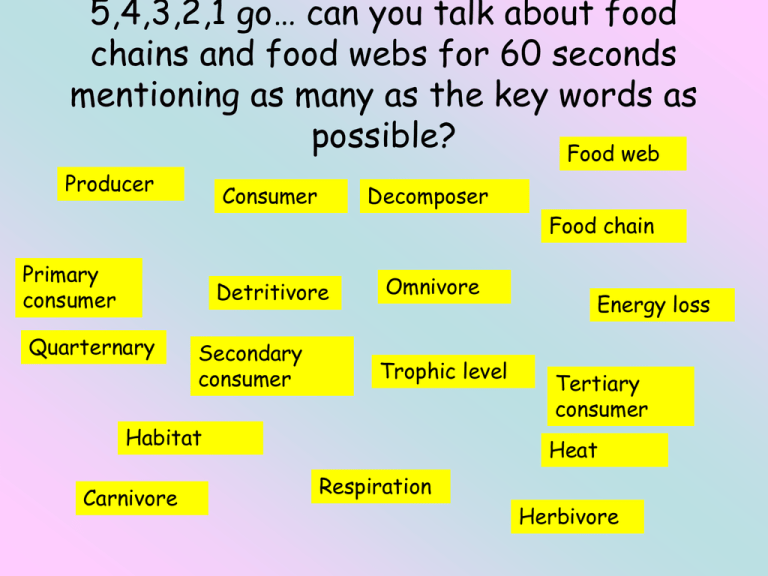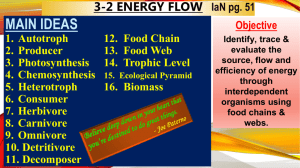5.3_Ecological_pyramids
advertisement

5,4,3,2,1 go… can you talk about food chains and food webs for 60 seconds mentioning as many as the key words as possible? Food web Producer Consumer Decomposer Food chain Primary consumer Detritivore Quarternary Secondary consumer Omnivore Trophic level Habitat Carnivore Energy loss Tertiary consumer Heat Respiration Herbivore Ecological pyramids We Are Learning: About how energy moves and is lost between trophic levels. • What are the different types of ecological pyramid? • What are the relative merits and disadvantages of each? •What percentage of energy is transferred from one level to the next? Today we are covering from the specification: Review – Energy in Food Chains Exam question Ecological Pyramids • Food chains and food webs are a useful means of showing what different organisms eat and therefore energy flow. • PROBLEM: They do not provide quantitative information. • SOLUTION: ecological pyramids., e.g. Pyramids of Numbers What information do they give us? Number of organisms in an ecosystem at each trophic level. BUT… They can look odd 9 Pyramids of Numbers - Issues 1) No account is taken of size – one tree is given the same value as 1 aphid therefore they can look inverted. 2) The number of individuals is so great that it is impossible to represent them accurately on the same scale as other species in the food chain – e.g. one tree and 1 million aphids. They can look odd 10 Pyramids of Numbers – Another Example Pyramids of biomass • More reliable, quantitative description of a food chain is provided when their biomass is measured. • Biomass is the total dry mass of the plants and/or animals in a particular place. Pyramids of Biomass Biomass = dry mass of organisms Given as kgm-2 for an area Or kgm-3 for a volume 13 Measuring biomass Problem: finding the biomass of worms Why is this so hard? How would you do it? 14 Problem 1: variability due to moisture content. Solution: dry your earthworms at 60˚C for 24-48 hours to get “dry earthworm biomass”. Problem 2: variability due to gut contents. Solution: • Keep the live earthworms in containers until they empty their guts (24-48 hours, if they don’t die in the process); • Dissect the preserved earthworm and flush their opened gut; • “Ash-dry” worms leaving only mineral gut contents. 15 What do we find? A statistical relationship between length & dry biomass Dry worm & weigh “ash-dry” at 500 ˚C Remove ash Weigh gut contents Subtract gut contents weight from dry weight Q. Why is the graph so useful? 16 Pyramids of biomass • Fresh mass is quite easy to access but varying amounts of water makes it unreliable. • Use dry mass but the organisms must be killed; – Usually a small sample, which may not be representative. So, why do we usually see this shape for pyramids of biomass? • Energy is ‘lost’ at each stage in the food chain (see previous lessons!), so there is less energy available at each subsequent trophic level to create new biomass. Pyramids of Biomass – an exception to the rule Anomaly from pyramid of biomass with aquatic food chain Q. Why is there less biomass in producers than primary consumers? A. Sample is made at a single point in time and plant biomass may vary with season. Phytoplankton may also be reproducing quickly and so large turnover of biomass. 19 Pyramids of energy • Most accurate representation of energy flow through an ecosystem. • Collecting data can be difficult and complex. • Data are collected in a given area (e.g. one square metre) and in a set time (e.g. a year). • Results are more representative than those for biomass as 2 organisms of the same biomass may store different amounts of energy. (1g of fat stores 2x quantity of energy of 1g of carbohydrate.) Pyramid of Energy Always a true pyramid-shape…why? Energy stored in each trophic level of a Florida ecosystem Energy KJ m-2 y-1 Q. Why might deriving energy content be difficult? A. Two organisms of the same dry mass may have different energy contents e.g. more or less fat which is high in energy. 21 Task Past paper questions.






